Sound is a type of energy made by vibrations. When any object vibrates, it causes movement in the air particles. These particles bump into the particles close to them, which makes them vibrate too causing them to bump into more air particles. This movement, called sound waves, keeps going until they run out of energy. If your ear is within range of the vibrations, you hear the sound.
Production of sound
The to and fro or back and forth motion of an object is called vibration. When a tightly stretched band is plucked, it vibrates and produces sound. When it stops vibrating, it does not produce any sound. We see that a vibrating object produces sound. In some cases, the vibrations are easily visible to us. But in most cases, their amplitude is so small that we cannot see them, however, we can feel them.
All musical instruments have vibrating parts, which produce sound. In human beings, sound is produced by the voice box or the larynx.
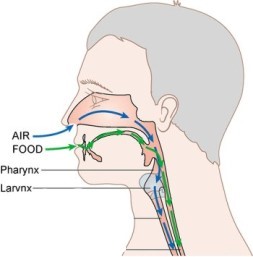
We hear through the vibration of our eardrum, whenever sound reaches our ears.
Also Check: Force
Sound as Energy
Sound is produced due to vibration and to start vibration energy is required. Therefore, sound is energy.
Sound as Wave
Going back to the definition of wave, a ’wave’ is a disturbance (an oscillation) that travels through space as time passes. It is accompanied by transfer of energy. Hence, sound is also a form of wave.
Sound wave is a longitudinal wave i.e. the sound energy propagates in the direction of vibration of particle.
PROPAGATION OF A SOUND WAVE (LONGITUDINAL WAVE)
Sound cannot travel through vacuum. It requires medium to travel. Sound propagation is due to vibration of the particle of the medium.
The figure on the next page shows a longitudinal sound wave in air. In the Figure, all the regions marked C are compressions.
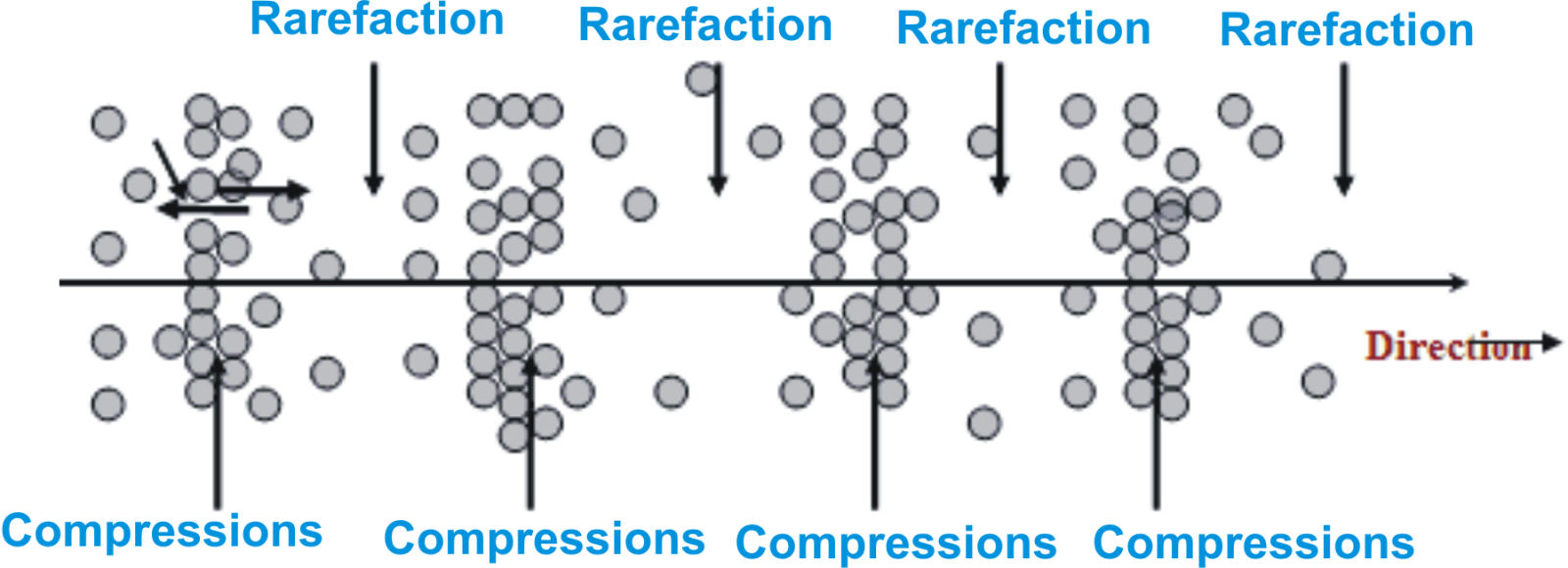
Diagram to show the compressions and rarefactions of a longitudinal wave.
A compression is that part of a longitudinal wave in which the particles of the medium are very close than normal, and there is a momentary decrease in the volume of the medium.
A rarefaction is that part of a longitudinal wave in which the particles of the medium are farther apart than normal, and there is a momentary increase in the volume of the medium.
Also Check: Frictional Force
Propagation of sound through solids
You might have done or seen that when we put our ear on a rail track through which trains generally passes, you can detect a train coming near you far before it has arrived due to the propagation of sound through rail track (solid).
Propagation of sound through liquid
Place a squeaking toy in a polythene bag and hold it in a bucket of water. Place your ear against the side of the bucket and squeeze the toy again and you all able to hear its squeak. This activity shows that sound can travel through liquids as well.
Propagation of sound through Air
Fill a balloon with air and press it to your ear, scratch the other end of it with your fingers. You will note that the sound reaches your ear. This activity shows that sound can also travel through gases.
The velocity of sound is approximately330 m/s at standard temperature (273.15K i.e. 00C) and pressure condition (100 kPa i.e. 0.986 atm). It varies with temperature, pressure, humidity and density of medium.
Velocity of sound in different media
| Medium | Speed of Sound (m/s) |
|---|---|
| Gases | |
| Air | 330 |
| Carbon dioxide | 260 |
| Hydrogen | 1270 |
| Liquids | |
| Alcohol | 1210 |
| Turpentine | 1325 |
| Water | 1450 |
| Solids | |
| Copper | 3560 |
| Steel | 5100 |
| Glass | 5500 |
| Granite | 6000 |
From the above data it can be easily seen that the velocity of sound in solid is greater than water is greater than air.
Also Check: Thrust & Pressure
Characteristics of Sound
We hear different kinds of sounds in our surrounding. Each sound is different from the other. But what makes these sounds different?
A sound differs from the other sounds in three fundamental characteristics:
- Loudness: Loudness of sound is the degree of sensation of sound produced in ear. This characteristic property of sound distinguishes a feeble sound from a loud sound. Loudness depends upon the following factors.
- Response or Sensitivity of the Ear for Sound of that Frequency: (Loudness of the sound also depends upon the sensitivity of the ears of the listeners.)
- Amplitude of Vibration (Greater the amplitude louder is the sound.)
- Area of the Vibrating Body: (Larger the area of the vibrating body, louder is the sound produced. A large drum produces louder sound than a small drum.)
- Distance from the Source: (Loudness of sound decreases with an increase in distance of the listener from the source.)
- Pitch: Pitch is the characteristic which determines the shrillness of sound. If we press the keys of a harmonium one after another, different sounds are heard due to the difference in pitch. The pitch of a sound depends on the following two factors.
- Frequency of the Vibrating Body: With increase in frequency of the vibrating body, the pitch of sound increases.
- Relative Motion between the Source and the Listener : When the source is approaching or is being approached by a listener, the pitch of the sound appears to rise and when the source is receding or is goes farther away from the listener, the pitch of the sound appears to fall.
- Quality or Timber: The characteristic of sound which enable us to distinguish between two sounds of the same pitch and loudness, produced by two different sources is called its quality or timber.
Ques: Find the frequency an wavelength of a wave whose time period is 0.001 sec and speed is 200 m/s.
Solution:
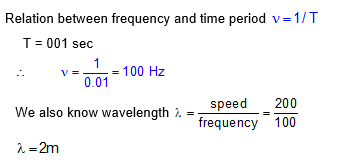
Ques: A source produces 12 waves in 4 sec. The distance between a crest and a consecutive trough is 6 m. Find
(a) frequency (b) wavelength (c) velocity of wave
Solution : Number of waves produced in 4 seconds = 12
Hence number of waves produced per second = 3
thus, frequency of wave 3 Hz
Distance between crest and consecutive trough = 6 m
Hence wavelength

We know wave speed
v = 2 x 12 = 36 m/s.
Also Check: Buoyant Force
Ques: Find the wave velocity, wavelength and frequency of wave shown in the figure.
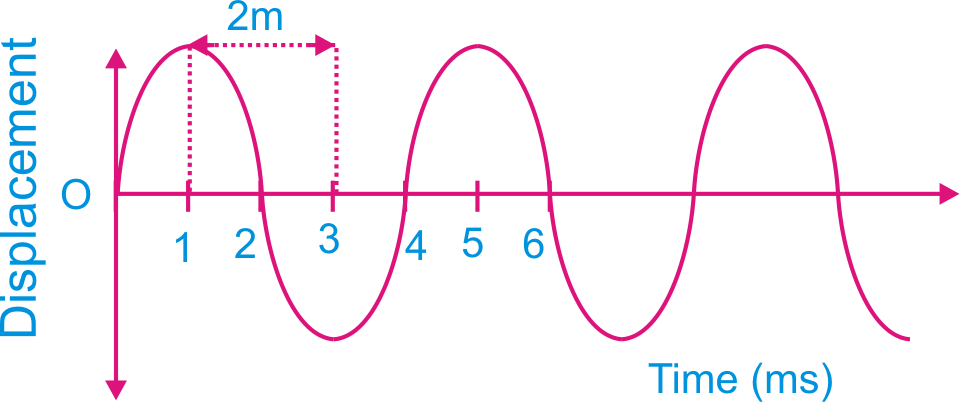
Solution : It is clear from figure
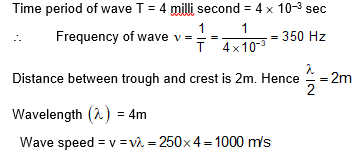
Audible and Inaudible Sounds
Sounds of frequencies less than about 20 vibrations per second (20 Hz) cannot be detected by the human ear. Such sounds are called inaudible. On the higher side, sounds of frequencies higher than about 20,000 vibrations per second (20 kHz) are also not audible to the human ear. Thus, for human ear, the range of audible frequencies is roughly from 20 to 20,000 Hz.
Sound of frequency 20 KHz is an ultrasonic sound and sound below 20 Hz is infrasonic sound. The ultrasonic and infrasonic sounds are not audible to humans as they are out of the human hearing range.
Some animals can hear sounds of frequencies higher than 20,000 Hz. Dogs have this ability. The police use high frequency whistles which dogs can hear but humans cannot.
The ultrasound equipment, familiar to us for investigating and tracking many medical problems, works at frequencies higher than 20,000 Hz.
Noise and Music
Some sounds are pleasant to the ear, whereas some are not.
Do you enjoy the sounds produced by horns of buses and trucks? Such unpleasant sounds are called noise. On the other hand you enjoy sounds from musical instruments. Musical sound is one which is pleasing to the ear. Sound produced by a harmonium is a musical sound. The string of a sitar also gives out a musical sound.
Noise Pollution: Unwanted sound is noise. These are unpleasant. Loud noise produces noise pollution, which is harmful and may cause harmful effect of human being as
- hearing impairment.
- Lack of sleep,
- hypertension (high blood -pressure),
- anxiety and many more.
A person who is exposed to a loud sound continuously may get temporary or even permanent impairment of hearing.
Also Check: Waves
Measures to control Noise Pollution
Some methods to control noise pollution are given below:
- Noisy operations and industries must be set up away from any residential areas.
- More trees should be planted along the rods and around building to act as nose buffers.
- Airport should be made away from residential area.
- Good quality silencers should be used in the engine of vehicles and aircraft.
- TV, music system, loudspeakers should be run at low volumes.
- Increasing public awareness about harmful effect of noise pollution by providing them factual information.
- Use of horns in the vehicles should be minimize.
SONIC BOOMS
When an object moves in air with a speed greater than the speed greater than the speed of sound in air, it is said to be traveling with supersonic sped. For example : Jet fighters, Bullets etc. often travel with supersonic speed
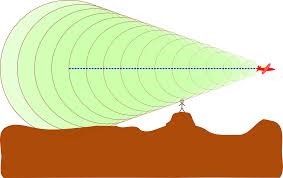
Due to motion of object with supersonic speed, shock waves are produced in air. These shock waves carry a great amount of energy and travel with speed of sound. These waves consist of a very high pressure layer followed by a lower pressure layer producing a burst or cracking sound called ‘Sound Boom’.
REFLECTION OF SOUND
Sound, like light also gets reflected at the surface where medium changes. Reflection of sound follows the law of reflection of light.
Real applications of reflection of sound:
Echoes
If we shout in a big empty hall, we hear again our voice coming due reflection of sound from wall a little later. This phenomenon is known as echo.
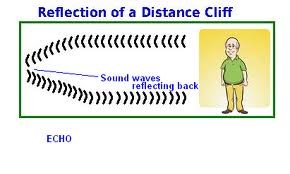
Minimum distance to hear an Echo: Our ears distinguish two sounds, separately only if there is a minimum time interval of 1/10th of a second. Now, by knowing the minimum time interval required for an echo to be heard, and the speed of sound in air, w can calculate the minimum distance from a sound reflecting surface, which is necessary to hear an echo.
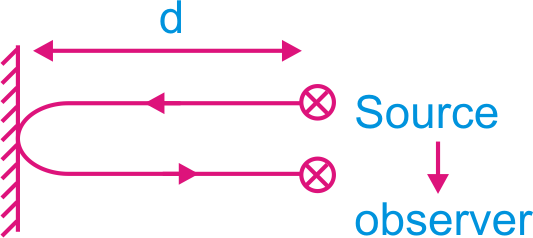
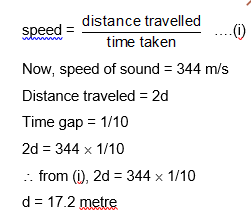
SONAR
The ‘SONAR’ is abbreviated from of sound Navigation and Ranging. The SONAR system is used for detecting the presence of unseen objects under water such as a submerged submarine, a sea-rock or hidden iceberg, and locating them accurately.
The SONAR employs ultrasonic waves for working. Due to its very high frequency, ultrasonic sound has a greater penetrating power than ordinary sound. These waves have frequency more than 20,000 Hz.
A SONAR apparatus consists of two parts (i) a transmitter (b) a receiver.
A SONAR device is attached to the ship and with its help we can measure the depth of an object lying at the bottom of sea. To do this, the transmitter sends ultrasonic waves into sea. This wave is reflected from bottom of see to the ship in the form of an echo. this echo produces an electrical signal in the receiver part of the SONAR device.
Let the time interval recorded between transmission and reflection of ultrasonic signal be t and object is at a depth h below water level then
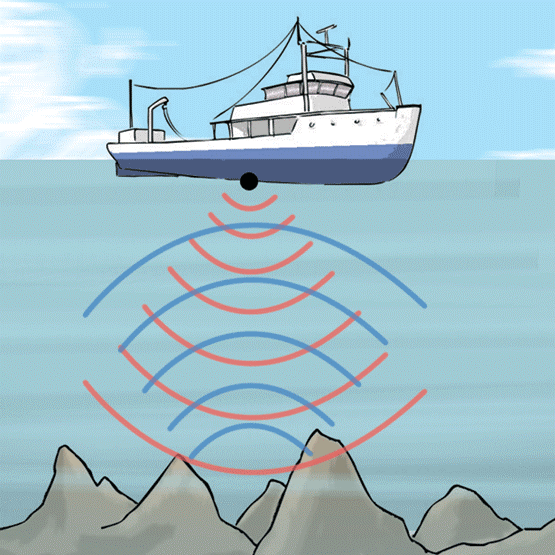
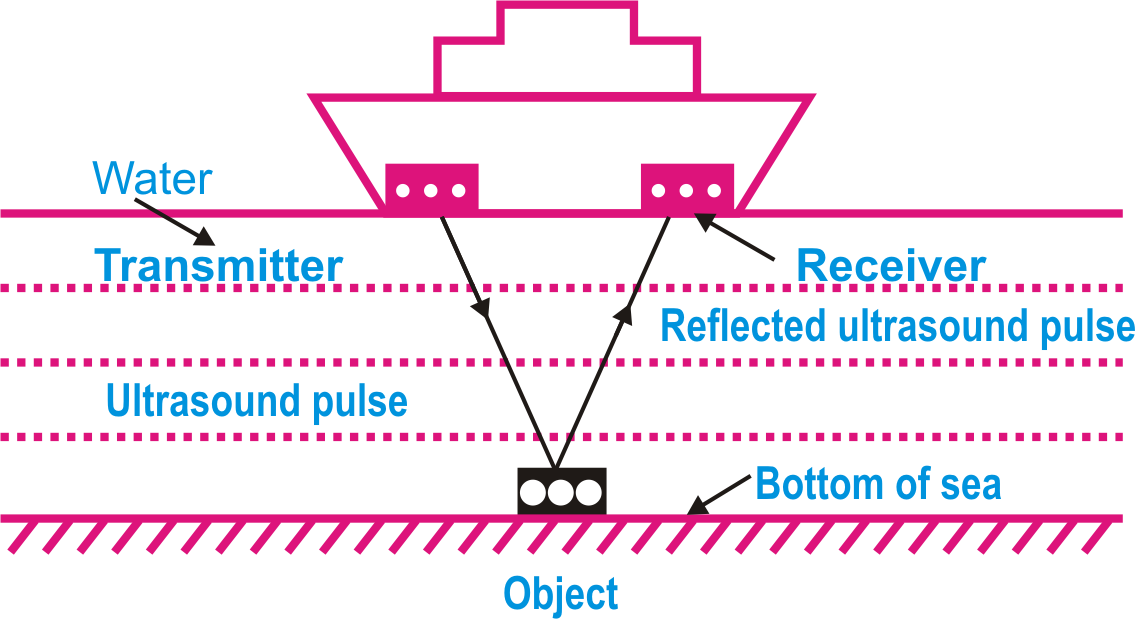
2h = v x t = v = speed of sound waves in water
h = vt /2
In nature too, the principle of the SONAR is used by bat. A bat can hear ultrasonic sounds of frequencies upto 120 KHz.
Ques: A person stands in between two walls and claps his hands. He hears two successive echoes at a time interval of 0.25 sec. If the distance between two is d and speed of sound in air is v, locate the position of person.
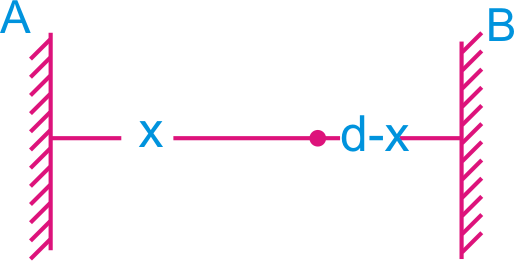
Solution:
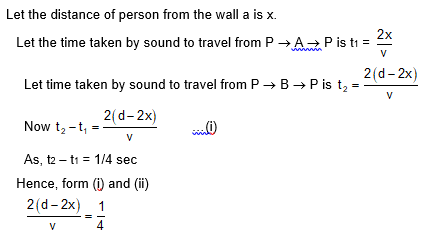
Frequently Asked Questions
Sound waves are called mechanical waves because they need a medium, like air or water, to travel through. They can't travel through empty space, like outer space.
Sound travels the fastest through solids, like metal or wood.
The frequency of a sound wave is how many times it vibrates in a second. It tells us how high or low the sound is.
Sound travels the slowest in gases, like air or helium.
Reverberation happens when sound bounces off many surfaces, like walls or floors, and comes back to our ears. It makes the sound seem to echo or last longer.
Related Links
| S.no | Formulas List |
|---|---|
| 1. | Force |
| 2. | Frictional Force |
| 3. | Thrust and Pressure |
| 4. | Buoyant Force |
| 5. | Waves |
| 6. | Sound |
| 7. | Some Natural Phenomena |
| 8. | Electroscope |
| 9. | Lightning |
| 10. | Earthquake |